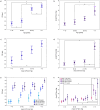Impact of age and mean intracranial pressure on the morphology of intracranial pressure waveform and its association with mortality in traumatic brain injury
- PMID: 39962578
- PMCID: PMC11834513
- DOI: 10.1186/s13054-025-05295-w
Impact of age and mean intracranial pressure on the morphology of intracranial pressure waveform and its association with mortality in traumatic brain injury
Abstract
Background: Morphological analysis of intracranial pressure (ICP) pulse waveforms provides indirect information on cerebrospinal compliance, which might be reduced by space-occupying lesions but also by intracranial hypertension and aging. This study investigates the impact of age and mean ICP on the shape and amplitude of ICP pulse waveform in traumatic brain injury (TBI). Additionally, it explores the association between morphological parameters and mortality after TBI.
Methods: ICP recordings from 183 TBI patients (median age: 50 (30, 61) years) from the CENTER-TBI database were retrospectively analyzed. ICP morphology was assessed using the artificial intelligence-based pulse shape index (PSI) and peak-to-peak amplitude of ICP pulse waveform (AmpICP). The impact of mean ICP, age, and their interaction on PSI and AmpICP were estimated using factorial ANOVA. To account for influence of disturbance in the intracranial volume on AmpICP and PSI, a multiple regression analysis was performed using age, mean ICP, and the Rotterdam CT score as explanatory variables. The associations of AmpICP and PSI with six-month mortality were assessed using the area under the ROC curve (AUC).
Results: Age had a predominant influence on PSI (p < 0.01), accounting for 33.1% of its variance, while mean ICP explained 6.6% (p < 0.01). Conversely, mean ICP primarily affected AmpICP (p < 0.01), explaining 22.8% of its variance, with age contributing 8.0% (p < 0.01). A combined effect of age and mean ICP on AmpICP (p = 0.01) explained 11.7% of its variance but did not influence PSI. After accounting for Rotterdam CT score, the results remained consistent, indicating that advanced age has the strongest impact on PSI (β = 0.342, p < 0.01) while elevated mean ICP has dominant influence on AmpICP (β = 0.522, p < 0.01). Both AmpICP and PSI were moderately associated with mortality (AUC: 0.76 and 0.71, respectively).
Conclusions: AmpICP and PSI capture distinct aspects of cerebrospinal compliance. PSI appears to reflect age-related stiffening of the cerebrovascular system, while AmpICP, influenced by mean ICP, indicates acute volume compensatory changes. Combined, they provide a more comprehensive assessment of cerebrospinal volume-pressure compensation. Both morphological metrics are associated with mortality after TBI. As cerebrospinal compliance declines with age, older TBI patients become more susceptible to uncontrolled rises in ICP, which can worsen their outcome.
Keywords: Aging; Cerebrospinal compliance; Intracranial pressure; Pulse waveform morphology; Traumatic brain injury.
© 2025. The Author(s).
Conflict of interest statement
Declarations. Ethics approval and consent to participate: The CENTER-TBI study (European Commission [EC] grant 602150) has been conducted following all relevant laws of the European Union (EU) if directly applicable or of direct effect and all relevant laws of the country where the recruiting sites were located, including but not limited to, the relevant privacy and data protection laws and regulations (the "Privacy Law"), the relevant laws and regulations on the use of human materials, and all relevant guidance relating to clinical studies from time to time in force, including but not limited to, the International Conference on Harmonization (ICH) Harmonized Tripartite Guideline for Good Clinical Practice (CPMP/ICH/135/95; "ICH GCP") and the World Medical Association Declaration of Helsinki entitled "Ethical Principles for Medical Research Involving Human Subjects." Informed consent from the patients and/or the legal representative/next of kin was obtained, accordingly to local legislation, for all patients recruited in the core data set of CENTER-TBI and documented in the electronic case report form. Ethical approval was obtained for each recruiting site. The list of sites, ethical committees, approval numbers, and approval dates can be found on the study website ( https://www.center-tbi.eu/project/ethical-approval ). The data used in this study were obtained (with permission) in the context of CENTER-TBI, a large collaborative project with the support of the European Union 7th Framework program (EC grant 602150). Consent for publication: Not applicable. Competing interests: MC receives a share of the licensing fee of ICM+ software (Cambridge Enterprise Ltd, UK). ES is the co-founder and shareholder of X-PRESSURE. The other authors declare that they have no conflicts of interest.
Figures



References
-
- Marmarou A, Shulman K, LaMorgese J. Compartmental analysis of compliance and outflow resistance of the cerebrospinal fluid system. J Neurosurg. 1975;43:523–34. 10.3171/jns.1975.43.5.0523. - PubMed
-
- Lofgren J, von Essen C, Zwetnow NN. The pressure-volume curve of the cerebrospinal fluid space in dogs. Acta Neurol Scand. 1973;49:557–74. 10.1111/j.1600-0404.1973.tb01330.x. - PubMed
-
- Czosnyka M, Czosnyka ZH, Whitfield PC, Donovan T, Pickard JD. Age dependence of cerebrospinal pressure-volume compensation in patients with hydrocephalus. J Neurosurg. 2001;94:482–6. 10.3171/jns.2001.94.3.0482. - PubMed
-
- Howells T, Lewén A, Sköld MK, Ronne-Engström E, Enblad P. An evaluation of three measures of intracranial compliance in traumatic brain injury patients. Intensive Care Med. 2012;38:1061–8. 10.1007/s00134-012-2571-7. - PubMed
MeSH terms
Grants and funding
LinkOut - more resources
Full Text Sources
Medical
Research Materials

